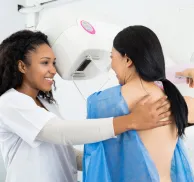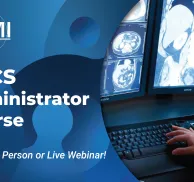Diverse, fascinating, and essential, the rapidly growing field of radiology offers exciting opportunities for ambitious professionals. Among the many available niches is a path that may seem familiar but is not well-understood outside of the healthcare sector: computed tomography.
This imaging technique is crucial for providing insight into internal anatomy. It plays a central role in diagnosing and understanding many conditions. Successful scans would not be possible, however, without the hard work of specialized radiologic technologists.
Keep reading to learn why this imaging modality is so important and how dedicated CT technologists make a difference for patients and clinical employees alike.
What Is a CT Technologist?
A computed tomography (CT) technologist is a specialized practitioner responsible for producing cross-sectional images. These, along with in-depth feedback from the technologist, help radiologists diagnose a variety of diseases and acute conditions.
MTMI's Mark Bake, DBA, MS, BS, RT(R)(CT) explains that this role is defined, in part, by the technologist's background and how they handle imaging. "A CT technologist generally has a radiology background and obtains special cross-sectional imaging to help providers diagnose a patient."
CT techs usually work in a hospital, a provider’s office, or a freestanding imaging center.
What Does a CT Tech Do?
CT techs are responsible for operating assigned scanning equipment to perform the radiologic exams. This produces diagnostic images of the patient's anatomy, which can then be sent to radiologists for analysis. Should any issues involving the equipment or technology arise, CT techs should document and report these concerns promptly.
According to Bake, one of the main distinctions between the CT tech's role and that of other radiology professionals involves the sheer quantity of images produced. He explains that, instead of relying on just one or two images, CT techs "take hundreds of images in a very short time period." Technologists may also be asked to work closely with radiologists to guide drainages or biopsies.
There's more to CT scanning than simply operating equipment. These empathetic professionals interact closely with patients and can provide a much-needed source of comfort during a difficult or overwhelming time.
CT techs should maintain a patient-centered approach, complete with detailed and helpful instructions, plus empathetic responses as patients ask questions or cite concerns. This is particularly important while utilizing IV contrast, as patients may need to hold still for what, to them, feels like a substantial amount of time.
What Is Computed Tomography?
The everyday work of a CT tech is difficult to understand without recognizing the inherent complexity and value of computed tomography, a non-invasive diagnostic procedure. This cross-sectional imaging technique involves a series of X-rays, which are taken from many angles to produce detailed images of the soft tissues, blood vessels, and bones.
Computed tomography (CT) is often confused with other imaging solutions. Technologists must be thoroughly familiar with all imaging approaches, as they will occasionally come across situations in which they're asked to perform CT scans but ultimately realize that other imaging techniques are preferable. Our breakdown of common terms and abbreviations should help you understand where and when CT scans come into play.
CAT Scan vs. CT Scan
Many patients are surprised to discover that the terms CAT scan and CT scan reference the same type of diagnostic procedure. Short for "computed axial tomography," CAT was widely used for years but has since been largely replaced by the simpler term "computed tomography."
Given the increased versatility of today's machines, the previous terminology is not always entirely accurate. Today's machines utilize sagittal or coronal planes in addition to the axial images for which they were originally known. The ‘A’ in CAT scan was therefore dropped from the acronym, changing it to CT.
PET/CT vs. SPECT/CT
Positron emission tomography (PET) relies on tracers to provide insight into metabolic activity. These tests may be completed along with CT scans or even built into a single scanner known as the PET/CT.
Single photon emission computed tomography (SPECT) involves a lower-cost alternative that replaces positron-emitting radioisotopes with gamma-emitting radioisotopes. This produces less contrast but remains a valuable option for analyzing a variety of organs and tissues.
Both PET and SPECT make it possible to blend aspects of nuclear medicine with CT. This is especially valuable when diagnosing or staging cancer, as the combination of these modalities can reveal hotspots indicating whether (or to what extent) cancer has spread.
CT vs. MRI vs. X-Ray
CT scans are often confused with MRI scans and X-rays. All share the basic purpose of assisting with diagnostics, but there are many considerable differences worth addressing.
CT scans produce remarkably high levels of detail and are frequently relied upon in emergencies and trauma. These scans may reveal pathologies such as blood clots and can often pinpoint subtle fractures that are difficult to spot via X-rays. Still, X-rays have their place: in first-line imaging, especially when expedited results are required.
Meanwhile, MRIs avoid radiation altogether and are therefore distinct from both X-rays and CT scans. Although they can be valuable in many contexts, MRIs are most commonly used to gather information on various musculoskeletal conditions. MRI technologists require their own specialized training to learn this unique imaging technique.
How to Become a CT Technologist
With so many types of scans available for modern diagnostics, there is an increased need for niche skills, including the ability to operate and understand highly complicated equipment. Among these many opportunities, CT technology is especially compelling, given the prevalence of CT scans within urgent care.
The path to becoming a CT technologist is similarly diverse. In general, any aspiring radiologic technologist can expect to follow a few basic steps: get the right degree and certification followed by a state license, if required. We delve into each step in detail below:
1. Degree in Radiology
An associate degree is a must for any radiologic technologist, but it is especially important for anyone who wants to eventually work in computed tomography. The right degree will provide a strong foundation in anatomy, physiology, and medical terminology while also helping aspiring technologists develop stronger communication and collaborative skills. Radiology remains the main method for getting into CT—and CT is often purposefully built into the curriculum.
2. ARRT Certification
Following graduation, take steps to get certified with the American Registry of Radiologic Technologists ® (ARRT ®). Offering credentials in a variety of disciplines, ARRT is the industry's go-to resource for everything from magnetic resonance imaging to nuclear medicine technology.
Certification in computer tomography is available, but you will need to meet a variety of clinical experience and structured education requirements to qualify. CT represents a post-primary form of certification, so it must be preceded by ARRT credentials in supporting disciplines.
3. State Licensure (If Necessary)
State requirements can vary significantly, so take a close look at rules and regulations in your region to determine whether you need to take any additional steps to get licensed after you secure your degree and ARRT certification. When in doubt, look to the American Society of Radiologic Technologists (ASRT) for insight into state-by-state licensure.
4. CE, Conferences, Networking
Becoming a CT technologist is only the beginning. Once you've scored your dream job, you'll need to keep your skills up to date. This means completing a minimum number of continuing education (CE) requirements during a two-year window known as a biennium.
This is also a great time to build a strong professional network, which is crucial for improving your job prospects and continuing to advance in your field. Draw on the power of your alumni network but don't hesitate to also attend industry conferences, which boost your network while also exposing you to cutting-edge concepts.
A strong social media presence can also prove valuable. Begin by overhauling your LinkedIn page to ensure it looks as professional and relevant as possible.
How Long Does It Take to Become a CT Tech?
The timeline to becoming a CT tech can vary significantly based on the type of college program completed, the amount (and type) of experience acquired, and the process of meeting eligibility requirements (and studying) for the appropriate ARRT credentials.
Many aspiring CT technologists gain experience in other areas of radiology before eventually specializing in CT, so this can also expand the timeline. Between degree programs and certification requirements, most aspiring CT techs can expect to spend several years preparing for this role.
Do CT Techs Have to Be Registered?
Getting registered or licensed is not always strictly required, but it's always a good idea. A lot depends on geographic location and the preferred type of facility. In general, getting registered will expand the range of available jobs and advancement opportunities—so it is valuable for that reason alone.
CT Tech Career Outlook
The time and effort required to become a CT tech should more than pay off, as this career path provides a strong outlook and plenty of job opportunities. These can be found within several types of facilities and in many healthcare specialties.
How Much Do CT Techs Make?
In CT, as in any area of radiology, earnings can vary considerably based on geographic region, education, experience, and many other factors—but at the outset, CT wages may reflect the general radiologic pay ranges outlined by the Bureau of Labor Statistics (BLS): an annual median of $61,370. Mark Bake adds that many employers will provide increases in pay based on specialized training.
Career Growth for CT Techs
If you have ambitious plans for your career in radiology, you will be pleased to discover that this field provides plenty of opportunities for advancement. With sufficient training and experience, it may be possible to move into the role of imaging supervisor. This involves oversight of a variety of staff members, along with quality assurance and strict record-keeping. Other opportunities might include clinical research or even instructing new CT and radiology students.
Technology Changes
As imaging technology advances, you'll need to be prepared to adapt accordingly. This means embracing new tools or techniques—and eventually, embracing changes in how CT results are produced and communicated.
Perhaps the most noteworthy change involves advancements in post-processing, with new solutions allowing for three-dimensional reconstructions that convey anatomy in even more detail. CT techs are increasingly responsible for processing these images and must therefore be capable of manipulating them to help radiologists achieve the most impactful insights.
Get Certified in CT with Help from MTMI
As a CT technologist, you will play a critical role in helping patients obtain prompt and accurate diagnoses, all while making them feel as comfortable, respected, and supported as possible. First, however, you will need in-depth training, which will delve not only into advanced imaging technologies and techniques but also into patient care and collaboration with other healthcare professionals.
If you’re looking for the best start in CT, consider MTMI’s CT Course for Technologists. This bootcamp is designed for technologists with no previous CT experience as well as techs who have worked in CT without extensive formal training. We also offer a CT Registry Review webinar series for comprehensive exam prep along with other CT webinars to meet your CE requirements.
MTMI offers a variety of additional courses and webinars of value to both current and aspiring CT techs as well as physicists working in computed tomography. Look to MTMI for ongoing CT training and CE opportunities.
Our programs are taught by experts with national reputations in their fields and cover many modalities. MTMI’s cross-training courses, offered in the classroom as well as via webinars, prepare you for registry exams and take your career to the next level. Check out our full catalog of programs or contact us with questions today!






